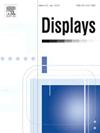用于显示特征的机器学习方法比较分析
IF 3.7
2区 工程技术
Q1 COMPUTER SCIENCE, HARDWARE & ARCHITECTURE
引用次数: 0
摘要
本文探讨了各种机器学习方法在表征 LCD、OLED 和 QLED 技术显示屏方面的应用,以实现准确的色彩再现。这些模型由三种不同显示器的输入(与设备相关的 RGB 数据)和输出(与设备无关的 XYZ 坐标)数据组成。训练和测试数据集是使用直接从显示器测量的 RGB 数据和使用高精度色度计测量的相应 XYZ 坐标建立的。这项研究的一个重要方面是应用模糊推理系统建立可解释的模型。这些模型的优势在于不仅能实现良好的色彩还原性能,还能提供有关 RGB 输入和 XYZ 输出结果之间关系的物理洞察力。这种可解释性有助于加深对显示器行为的理解。此外,我们还将模糊模型的性能与其他流行的机器学习方法(包括基于神经网络和决策树的方法)进行了比较。通过评估每种方法的优缺点,我们旨在找出最有效的显示表征方法。每种方法的有效性都是通过其准确再现和显示色彩的能力来评估的,并用 ΔE00 视觉误差指标来衡量。我们的研究结果表明,模糊建模和识别 (FMID) 方法特别有效,能够在高精度和可解释性之间实现最佳平衡。在所有显示类型中,该方法的性能都很有竞争力,再加上其宝贵的可解释性,为未来潜在的校准和优化策略提供了启示。研究结果将揭示机器学习方法是否比传统物理模型更具优势,尤其是在数据有限的情况下。此外,这项研究还将有助于人们了解模糊推理系统在液晶显示屏表征方面提供的可解释性优势。本文章由计算机程序翻译,如有差异,请以英文原文为准。
A comparative analysis of machine learning methods for display characterization
This paper explores the application of various machine-learning methods for characterizing displays of technologies LCD, OLED, and QLED to achieve accurate color reproduction. These models are formed from input (device-dependent RGB data) and output (device-independent XYZ coordinates) data obtained from three different displays. Training and test datasets are built using data measured directly from the displays and corresponding coordinates measured with a high-precision colorimeter. A key aspect of this research is the application fuzzy inference systems for building interpretable models. These models offer the advantage of not only achieving good performance in color reproduction, but also providing physical insights into the relationships between the inputs and the resulting outputs. This interpretability allows for a deeper understanding of the display’s behavior. Furthermore, we compare the performance of fuzzy models with other popular machine-learning approaches, including those based on neural networks and decision trees. By evaluating the strengths and weaknesses of each method, we aim to identify the most effective approach for display characterization. The effectiveness of each method is assessed by its ability to accurately reproduce and display colors, as measured by the visual error metric. Our findings indicate that the Fuzzy Modeling and Identification (FMID) method is particularly effective, allowing for an optimal balance between high accuracy and interpretability. Its competitive performance across all display types, combined with its valuable interpretability, provides insights for potential future calibration and optimization strategies. The results will shed light on whether machine learning methods offer an advantage over traditional physical models, particularly in scenarios with limited data. Additionally, the study will contribute to the understanding of the interpretability benefits offered by fuzzy inference systems in the context of LCD display characterization.
求助全文
通过发布文献求助,成功后即可免费获取论文全文。
去求助
来源期刊

Displays
工程技术-工程:电子与电气
CiteScore
4.60
自引率
25.60%
发文量
138
审稿时长
92 days
期刊介绍:
Displays is the international journal covering the research and development of display technology, its effective presentation and perception of information, and applications and systems including display-human interface.
Technical papers on practical developments in Displays technology provide an effective channel to promote greater understanding and cross-fertilization across the diverse disciplines of the Displays community. Original research papers solving ergonomics issues at the display-human interface advance effective presentation of information. Tutorial papers covering fundamentals intended for display technologies and human factor engineers new to the field will also occasionally featured.
 求助内容:
求助内容: 应助结果提醒方式:
应助结果提醒方式:


